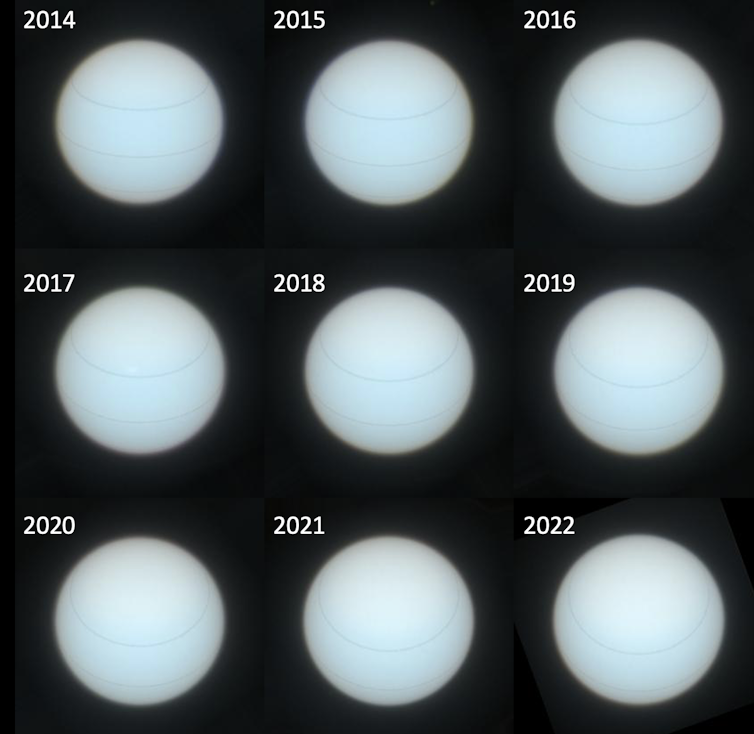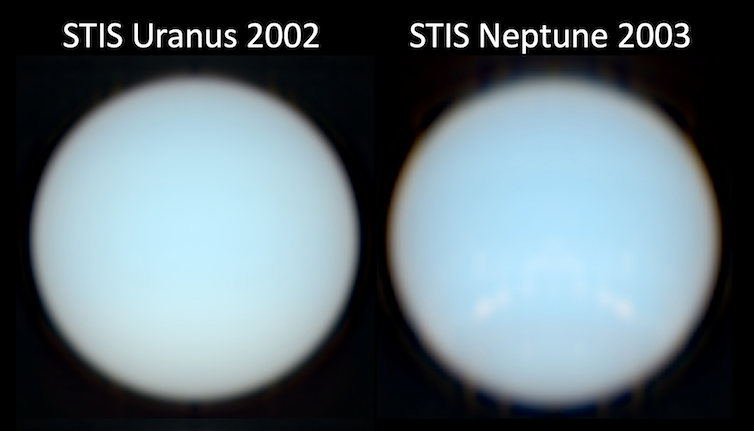In many images of the two outer gas giants of the Solar System, Neptune typically looks rich blue while Uranus comes across as pale green. But now our new study, published in Monthly Notices of the Royal Astronomical Society, has revealed that these two ice giants are actually very similar shades of greenish blue.
The study follows our previous work in 2022 that analysed the spectra (light broken down by wavelength) of light reflected off Uranus and Neptune from several sources, including the space telescope imaging spectrograph on the Hubble space telescope. These were recorded in 2002 (Uranus) and 2003 (Neptune).
We found that the colours of Uranus and Neptune were actually remarkably similar, with Neptune appearing only slightly bluer – see the image below. The difference in colour was attributed to the difference in opacity of a layer of haze and methane ice.
Author provided (no reuse)
Ultimately, Neptune has a thinner layer of haze, allowing more sunlight to reach deeper in the atmosphere. At such depth, it can be absorbed by methane gas, which soaks up red light – making the planet appear ever so slightly more blue.
Reconstructing the colours
Our reconstructed colours of Uranus and Neptune look very different from previous images, which come from the Voyager 2 spacecraft’s encounters with these planets in 1986 and 1989 respectively.
So, did the colours of Uranus and Neptune change between the late 1980s and early 2000s? Or do we need to consider more carefully how observations of planets are converted to the “true” colour that would be observed by an average human observer? The answer, it turns out, is a bit of both.
Colour images of planets are highly processed. The red, green and blue components are usually recorded separately by spacecraft. They are then sent back to Earth as black-and-white images, where they can be combined in colour. However such images may not reveal the true colour the human eye would see.
Even light recorded in channels beyond the visible range, such as in ultraviolet, become red, green or blue when displayed. There are several steps involved in this process and, depending on the choices made, a planetary image can have a wide range of appearances.
To determine the truest colour of Uranus and Neptune up to the present day, we combined our Hubble data with more recent observations at the very large telescope in Chile. Both of these instruments record images where each individual pixel is a complete, continuous spectrum covering all colours that can be seen with the human eye – making them more accurate than spacecraft when it comes to colour.
This allowed us to determine unambiguously the actual colour that the human eye would perceive for Uranus and Neptune. We could then reprocess observations made by imaging cameras on Voyager 2 and Hubble taking this into account.
When the reprocessed Voyager 2 observations of Uranus and Neptune are compared with some of the early-release images, it is clear that the early Uranus images correspond fairly well with what we now believe its colour to be. The early Neptune images, however, are a much darker blue than their true colour.
This difference was actually known at the time to the Voyager imaging team, and the captions released with the images explained this fact. However, since the purpose of these images was to communicate the exciting new discoveries of the mission, it was quite sensibly judged that an enhanced version of the images that accentuated the discoveries was preferable over a “true” colour version, where the features appear washed out.
However, the differences in processing became forgotten over time and so now most people, including planetary researchers, just accept that Neptune is much bluer than Uranus, which is not actually the case.
Uranus changes colour
Comparing the true colour of Uranus in 1986 with more recent observations, it became clear that Uranus in 1986 was actually slightly greener than it was in the early 2000s. We tried to determine why this was the case by turning to observations made between 1950 and 2016 at the Lowell Observatory in Arizona. These observations contained the overall brightness of Uranus and Neptune almost annually at two wavelengths: green and blue.

CC BY-SA
This revealed that Uranus does change colour, becoming greener at the solstices (when the Sun’s path in the sky is the farthest north or south from the planet’s equator) than it is at the equinoxes (when the Sun’s path crosses the planet’s equator).
Part of the reason for this colour change is that Uranus spins almost on its side during its 84-year orbit about the Sun. This means that, during the planet’s solstices, either its north or south pole points almost directly towards the Sun and Earth. Hence, polar latitudes dominate the overall reflectivity.
This led us to develop a model which compared the spectra of Uranus’ polar regions to its equatorial regions. We found that polar regions are more reflective at green and red wavelengths than blue wavelengths, partly because methane is half as abundant near the poles than the equator.
However, this didn’t fully explain the colour change. To match the Lowell Observatory data, we found that we also need to add a “hood” of icy haze over the summer. This modified model then substantially reproduced the Lowell observations and thus explains how the overall colour of Uranus changes during its orbit about the Sun.
So the next time you see an old image of the two gas giants, keep in mind you’re probably not seeing their “true” colour.




